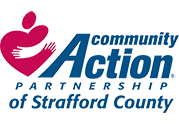Connect With Us
How You Can Help
Visit Us
Community Action Partnership of Strafford County is a 501(c)(3) private nonprofit organization established under the provisions of the Equal Opportunity Act of 1964 and established in Strafford County in May of 1965.
© 2024 Community Action Partnership of Strafford County. All Rights Reserved. Website by MyDesignSpace, Inc.
Privacy Policy | Sitemap

